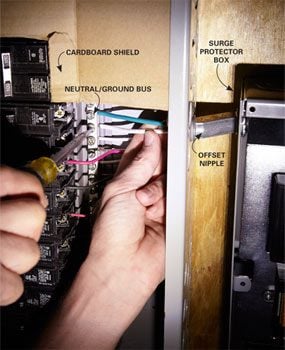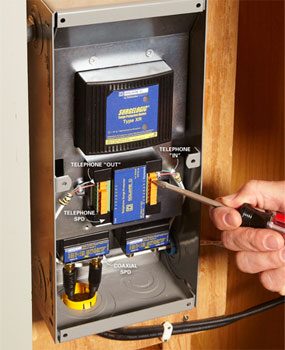How Much to Install Whole House Surge Protector
Power Surge: Protect All Your Electronics
Protect your sensitive electronics from voltage spikes
 Family Handyman
Family Handyman
Install a whole house surge protector to prevent your plug-in electronics from voltage surges caused by lightning strikes. Follow our step-by-step directions and cautions for a safe installation.
You might also like: TBD
The benefits of whole house surge protection
You might have plug-in surge protectors on some of your electronics, but you probably don't have them for appliances with electronic circuit boards. Those electronics are sitting ducks for power surges generated by lightning strikes (even if the strike is miles from your home). Most newer appliances, cable boxes, exercise machines and that new Bose Wave are all at risk. And it's not just lightning. Damaging power surges on the grid are common even when there isn't lightning around. It doesn't take much of a power surge to wipe out delicate electronics. It often costs as much to replace a circuit board as it does to buy a new device.
That's why everyone should have a whole-house surge protector. Those who live in rural areas are particularly vulnerable, especially if you live near the end of the power line. There's nowhere else for the surge to go but into your house.
A full-featured whole-house surge protection device (SPD) can protect all your electronics, appliances, telephone, Internet and cable TV equipment (the Square D No. SDSB1175C is one type; about $300 at spectrumsuperstore.com). Electricians charge about $175 to install it. But if you're comfortable working inside the main panel, you can do the job yourself and save the installation fee. The job takes about an hour. we'll show you how to do it.
Storm Tip
Installing a whole-house surge suppression device is the best way to continually protect your high-priced electronics. But if you know a storm is coming, you can protect against fried circuit boards by flipping off the breakers to your stove, dishwasher, furnace, A/C and fridge. Just make sure you turn them back on after the storm passes.
Buying a whole house surge protector
There's a lot of manufacturer hype surrounding surge protectors. Ignore all the mumbo jumbo and head right for the specifications. SPDs are rated in kiloamps (1kA equals 1,000 amps). The really inexpensive SPDs start at about 10kA. They can handle one really large surge and then they're toast—so they're a bad long-term investment.
Instead, look for an SPD with a minimum rating of 50kA. It'll last longer than a 10kA device.
If you've got telephone, DSL, cable or satellite service, get an SPD that protects those lines as well. Finally, make sure the device you choose complies with the most recent UL No. 1449 rating. Not all the equipment on the market meets the newer standard. Once you decide on an SPD, you'll also need a double-pole 15-amp breaker, one 1/2-in. rigid offset nipple and two 1/2-in. locknuts.
Warning: Electrocution Hazard!
Even with the service disconnect turned off, there are still live wires inside the main panel. If you don't know which ones remain live, don't attempt this project. Call a licensed electrician.
Can you install a whole house surge protector yourself?
You'll need two blank spaces, one on top of the other, in your main panel to hook up the SPD. Or, you can connect it to an existing two-pole 240V breaker—but only if that breaker is rated for two wires. To find out, call the breaker manufacturer's tech support line. If you don't have two blank spots in your main panel or the existing breakers aren't rated for two wires, you'll have to hire an electrician to install a subpanel. Or consider buying an SPD that installs right in the meter box (see "Is a Meter Socket SPD the Answer?" below).
First, the warnings. Even with the main breaker (service disconnect) off, there are still live wires inside the panel. If you touch them, you could die. So before you loosen a single screw on the main panel cover, read how to connect a new circuit. Read the entire article and pay particular attention to the diagram showing the dangerous areas. If you have any reservations about working inside the main panel, call a licensed electrician.
How to install the whole house surge protector

Photo 1: Secure the offset nipple to the main panel
Remove a knockout on the main panel and insert the offset nipple. Spin on the dimpled locknut with the locking "ears" facing the wall of the panel. Then tighten it with a flat-blade screwdriver and hammer.

Photo 2: Connect the neutral and ground to the bus
Strip off 3/4 in. of insulation from the neutral (white) and ground (green) wires and secure them to separate screws on the neutral bus.

Photo 3: Cut the black wires to length and install
Mark the two black wires from the SPD (a silver permanent marker works well). Then cut them to length and strip the insulation. Insert the bare wire into the breaker screws and tighten.

Photo 4: Connect the telephone wires to the SPD
Run the telephone wires from the demarcation device to the "in" connectors on the telephone SPD. Connect the house phone lines to the "out" terminals. Follow the same procedure for the cable TV lines.
Remove all rings and jewelry before unscrewing the main panel cover. Then flip the service disconnect to "off." Cut a cardboard protector and place it inside the panel to prevent contact with live wires. Remove the two circuit breakers directly below the service disconnect and relocate them and the wires running into them elsewhere in the panel. Position the SPD next to the main panel so the wires enter it as close as possible to the two vacant spots. Connect the offset nipple to the SPD and then to the main panel (photo 1). Secure the SPD to the wall with screws.
Next, thread the wires from the SPD into the main panel. Route the neutral (white) and ground (green) wires to the nearest screw terminals on the neutral bus (photo 2). Make the bends as gradual as possible. Keep all the wires (white, green, and black) as short as possible. Then snap in the new breaker and connect the two black wires from the SPD (photo 3).
To install telephone and cable surge protections, find the service "demarcation boxes" on the outside of your house. Run lengths of telephone and coaxial cable to the new SPD and connect them (photo 4).
As with all electrical projects, local electrical regulations always trump our advice. Always pull a permit and have your work inspected.
Is a Meter Socket SPD the Answer?
If your electrical panel is full or you're not up to doing your own installation, a meter socket SPD may be the perfect alternative. It snaps into the meter socket. Start by checking with your local power utility to see if it will allow a meter socket SPD. If so, find out how much it charges for installation—you can't install it yourself. Shown is the Leviton No. 50240-MSA, which is about $210. It is available through our affiliation with amazon.com.
Required Tools for this whole house surge protector project
Have the necessary tools for this DIY project lined up before you start—you'll save time and frustration.
Required Materials for this whole house surge protector project
Avoid last-minute shopping trips by having all your materials ready ahead of time. Here's a list.
Similar Projects
How Much to Install Whole House Surge Protector
Source: https://www.familyhandyman.com/project/power-surge-protect-all-your-electronics/